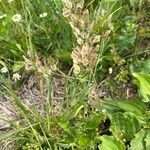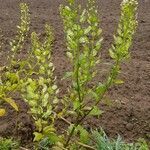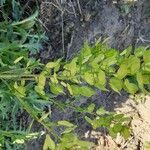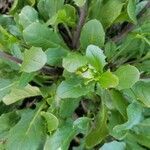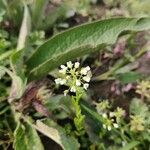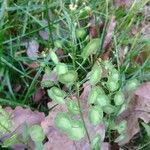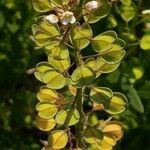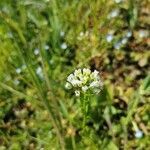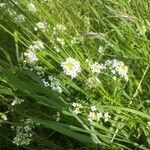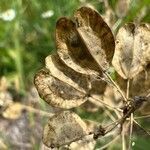Plants (sometimes glaucous), glabrous throughout. Stems (0.9-)1.5-5.5(-8) dm. Basal leaves not rosulate; petiole 0.5-3 cm; blade oblanceolate, spatulate, or obovate, 1-5 cm × 4-23 mm, base attenuate or cuneate, margins entire, repand, or coarsely dentate, apex rounded. Cauline leaves: blade oblong, (0.5-)1.5-4 (-8) cm × (2-)5-15(-25) mm, apex rounded, obtuse, or subacute. Fruiting pedicels straight or slightly upcurved, (5-)9-13(-15) mm. Flowers: sepals (1.5-) 2-3(-3.3) × 1-1.5 mm; petals (2.4-)3-4.5(-5) × (0.8-) 1.1-1.7 mm, narrowed to clawlike base (ca. 1 mm), apex obtuse or emarginate; filaments (1-)1.5-2.2 mm; anthers 0.3-0.5 mm. Fruits obovate or suborbicular, (0.6-)0.9-2 cm × (5-)7-20 mm, base obtuse or rounded, apex deeply emarginate, notch ca. 5 mm deep; wings broad throughout, 1-1.5 mm wide basally, 3.5-5 mm wide apically; ovules 6-16 per ovary; style 0.1-0.3 mm. Seeds (1.2-)1.6-2(-2.3) × 1.1-1.3 mm, concentrically striate. 2n = 14.
Annual glabrous herb. Stems erect, simple or branched above, foetid when crushed, 20-60 cm tall. Lvs entire to dentate. Lower lvs ovate to elliptic to spathulate, narrowed to base, withering at flowering, c. 2-4 × 1-2 cm. Upper lvs amplexicaul, ovate to oblanceolate, c. 2-4 × 0.5-1 cm. Racemes 10-30 cm long; pedicels erecto-patent at flowering, spreading at fruiting. Sepals spreading, 1.5-2 × c. 1 mm. Petals white, 2.5-4 × 0.8-1 mm. Silicle obovate to ± circular, deeply notched at apex, 1-1.5 × 0.8-1.5 cm; valves reticulately veined; wing to 5 mm wide; stigma ± sessile in notch of silicle. Seeds ovoid, furrowed, dark brown, not winged, c. 2 mm long.
Annual or biennial herbs 10-30 cm high, erect, glabrous. Basal leaves oblanceolate to obovate, petiolate, not in a rosette and dying off early. Stem leaves oblong, obovate-oblong to lanceolate, the lower ones shortly petiolate, the upper ones sessile, sagittate-amplexicaul, entire or repand-serrate. Racemes many-flowered, dense in flower, lax in fruit. Flowers small, white, the petals 2.5-3.5 mm long. Siliculae on ascending, 0.5-1.5 cm long pedicels, 1-1.5 x 0.8-1.3 cm, obovate-circular, broadly winged all round but wings broadest apically, emarginate, the sinus narrow and deep; stigma sub-sessile in the sinus. Seeds 5-8 per locule, 1.5-2 mm long.
Annual or biennial herb, 0.1-0.3 m high, erect, glabrous. Leaves: basal leaves petiolate, oblanceolate to obovate, dying off early; lower cauline leaves shortly petiolate, upper ones sessile, oblong, obovate-oblong to lanceolate, sagittate-amplexicaul, margins entire or repand-serrate. Inflorescence a many-flowered raceme, dense in flower, lax in fruit. Flowers small, white. Fruit a silicula, on ascending petioles, obovate-circular, broadly winged all around, wings broadest apically, emarginate. Seeds 5-8 per locule.
Glabrous annual or winter-annual 1–5 dm; cauline lvs sessile, oblong to lanceolate, entire or few-toothed, bearing at base 2 narrow, divergent, acute auricles 1–5 mm; fls 3 mm wide, the pet twice as long as the sep; mature pedicels ascending; frs orbicular to broadly elliptic, 10–17 mm, winged all around, deeply (2–3 mm) notched; seeds concentrically ridged-striate, numerous in each locule; 2n=14. Native of Europe, commonly established in waste places throughout much of N. Amer. Apr.–June.
Annual or rarely biennial herb 10–60 cm tall, erect, simple or branched, glabrous, somewhat foetid. Basal leaves petiolate, obovate to oblanceolate; cauline leaves sessile, auriculate, lanceolate. Sepals 1.5–2 mm long. Petals 3–4 mm long, emarginate, white. Stamens shorter than petals. Style 0.3 mm long. Silicula 12–22 mm diam., circular; valves strongly compressed, winged; wings broadening towards apex forming deep narrow apical notch. Seeds 1.5–2 mm long, ovoid, concentrically ridged.
A cabbage family herb. It is an annual plant. It grows up to 60 cm tall and spreads 1 m wide. The stem is erect and angular. The lower leaves are oval or sword shaped with teeth. These leaves have leaf stalks. The upper leaves clasp the stem at their base. The flowers are white and small. They are in long heads. The fruit is a pod. It is flattened.
